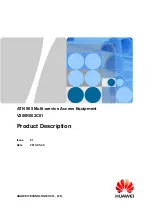Reviews:
No comments
Related manuals for WA6638

AirborneM2M APX-Q5 Series
Brand: B&B Electronics Pages: 105

ExtremeWireless WS-AP3915i-FCC
Brand: Extreme Networks Pages: 22

RAX15
Brand: NETGEAR Pages: 2

UAP-XG
Brand: UniFi Pages: 45

WAP-1000 WireFree
Brand: Planet Pages: 28

OBi100
Brand: Obihai Pages: 4

WAP54G - Wireless-G Access Point
Brand: Linksys Pages: 84

TEW-434APB - 54Mbps Wireless G PoE Access Point
Brand: TRENDnet Pages: 2

T073G HGU ONT
Brand: Calix Pages: 20

AP7050DE
Brand: Huawei Pages: 117

AP4130DN
Brand: Huawei Pages: 24

AP3010DN-AGN
Brand: Huawei Pages: 122

ATN 905
Brand: Huawei Pages: 78

AP5030DN
Brand: Huawei Pages: 25

AP4050DN-E
Brand: Huawei Pages: 172

AP6050DN
Brand: Huawei Pages: 37

AP6510DN-AGN
Brand: Huawei Pages: 17

AP8130DN
Brand: Huawei Pages: 33















